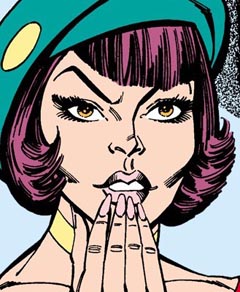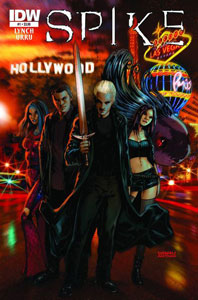Throughout my reread of IDW’s Angelverse work, it’s become increasingly clear that the “Spike” titles tend to be better than the “Angel” titles. There are some exceptions: “Spike: The Devil You Know” is not very good, and some “Angel” yarns are outstanding. But generally, your odds of getting a great tale are better with “Spike,” and it’s because Brian Lynch – with whom Joss Whedon co-wrote the canonical “Angel: After the Fall” — writes most of them, and Franco Urru does the art for most of Lynch’s work.
Lynch saves the best for last with the eight-issue “Spike” ongoing series (October 2010-May 2011). Despite having to adjust to the looming end of the IDW license partway through, Lynch crafts a strong tale of Spike’s time in Las Vegas. At first, Spike’s goal is to claim his own town to protect, since he couldn’t get out of Buffy’s shadow in Sunnydale or Angel’s in Los Angeles. Midway through the series, Lynch begins to link up the tale with “Buffy” Season 8: Spike calls on Willow for help – marking the first time IDW’s Angelverse and Dark Horse’s Buffyverse cross over. And the series wraps with Spike leading a spaceship full of dimension-hopping bugs, setting the stage for his entrance into Season 8.
Spike has a long-overdue reunion with Beck, securing her a pass from the Mosaic demon-rehab facility to join his team. I’ve always liked Beck, even though her “Firestarter” inspiration is obvious in the same way Gwen Raiden owes a debt to “X-Men’s” Rogue. Perhaps it’s because she’s a cute comic-book girl. But Lynch does more with her here, showing how she loves the heroic Spike, who cares for Beck but isn’t interested in romance at the moment.
Betta George is back on the team, too, and the banter between Spike and the floating telepathic fish sings from Lynch’s pen. Also surprisingly enjoyable are Spike’s exchanges with the ridiculous Groosalugg, who has always been a parody of noble medieval warriors, and fits the bill even better now that he’s teamed with the dragon named Cordelia. Jeremy is also around, and Lynch makes good use of him, first as the body that a W&H agent has possessed, and later as a Xander-like unsung hero (although it would be nice if Spike threw him a bone and stopped calling him “Jerry”).
An even more overdue reunion than Spike-and-Beck is Spike-and-Drusilla. Dru leaves Spike to hook up with a chaos demon between “Buffy” Season 2 and “Lovers Walk” (3.8). Then Spike rejects Dru in favor of Buffy in “Crush” (5.14), and the former vampire lovebirds hadn’t crossed paths since. In “Angel” Issues 25-26, we see Dru being studied in a secret underground laboratory, and in this “Spike” series we learn that lab is run by Wolfram & Hart, which values Dru’s prophetic visions.
A potential criticism of this series is that W&H’s aim for Las Vegas is similar to when it sends Los Angeles to Hell in “After the Fall.” A magic barrier around Sin City traps Spike’s team inside and makes conventional communication outside the city impossible — a parallel to Spike’s inability to contact his Vegas friends in “Spike: After the Fall.” On the flip side, this “Spike” series – probably accidentally – is a nice parallel to “Viva Las Buffy!” (Issues 51-54 of the classic Dark Horse series). In that story, a pre-Season 1 Buffy – like Spike here — focuses on discovering her purpose in life and tries not be distracted by romance amid the neon-lit casinos.

Forcing a W&H agent to give him magical help, Spike contacts Willow, who is on board for Issues 5-7. Willow’s connection with the Scooby Gang is dodgy through much of Season 8, so it makes sense that she could sneak away to help Spike here, and it’s nice to see them hug and to hear how Willow is proud of Spike for finding a purpose and making friends.
Having been granted permission (or given instruction) to use Willow as a guest star, Lynch isn’t afraid to unleash big ideas in these final issues, which are unfortunately his last in the Buffyverse. John, who had been a nebulously evil W&H associate up to this point, emerges as a great villain and a foil for Spike. A psychopathic human who only finds pleasure in killing, John loses his soul at the same time Spike gains his at the end of “Buffy” Season 6 — the latest Whedonesque reminder that there’s always a cosmic price. John wants his soul back so he can enjoy killing again, as his twisted enjoyment comes from feeling how wrong it is even as he does it.
Drusilla is a more traditional case. One thing leads to another among John’s and Willow’s dueling magics, and Dru ends up with the soul, and she’s messed up by it like Angel and Spike were in the past. Meanwhile, in a perfect encapsulation of Spike’s character, Spike stays a good guy even when his soul is removed. (Probably for the sake of tidiness, Spike regains his soul and Dru loses hers by story’s end.) At first, I thought Dru is poorly written in “Spike,” but then I realized that Dru has been made “sane” (or closer to it) while under W&H’s purview, and ultimately, Lynch delivers a fresh take on the character.
The showdown with John ends in showy fashion, but subtleties are also part of the joy of “Spike,” especially when Urru is at the easel for Issues 1, 2 and 8. Nicola Zanni (3-4) and Stephen Mooney (5-7) do an excellent job as pencillers on the other issues, with Andrea Priorini’s and Andrea Tentori’s colors helping to continue the Urru vibe, but Urru is still the master at working details into his panels. Without sacrificing the story’s flow, he gives us a parody of “Twilight” (the book and movie franchise) in Issue 1, as fans line up for “Re-clipse, Part 3 of the 4-Part Twinkle Trilogy.” “Twinkle” had become popular in the wake of “Last Angel in Hell,” an adaptation of the events of “After the Fall” where Spike is played by a woman.
As part of the Spike-George banter, Lynch inserts a jab at “Twilight,” too – in this case, the infamously off-target “Buffy” Season 8 (Issues 32-35) arc. Spike says Team Spike will be a small group of people he can trust; there will be “no back-stabbing, no dying, no picking up and leaving, and no aerial sex.”
Betta George: “I don’t understand that last one.”
Spike: “No one does.”
(Granted, Spike does not know Angel is Twilight at this point, let alone know about the events of the “Twilight” arc, which haven’t happened yet. So his reference is totally random. But, hey, Spike can be random sometimes, and it’s worth it for the inside joke.)
“Spike” Issue 8 almost directly links up with Spike’s “Buffy” Season 8 debut in Issue 35, but not quite, making me wonder if Lynch had something different planned had this series continued. At the end of the “Spike” series, Spike and his dimension-hopping insectoid allies aim to track down another bug ship that has been commandeered by Wolfram & Hart. In “Buffy” Season 8, Spike and the bugs pop up to help Buffy fight Twilight. So it seems there’s a missing story in between.
That said, Issue 8’s value is in establishing Spike’s friendship with the bugs and why they consider him to be their leader. In later stories, writers push the comedy of these bugs having human-like military jobs and the strange fact that Spike, of all people, is leading them. While I’m not a huge fan of adding large interdimensional insects to the Buffyverse, they become less silly if you keep the foundation of “Spike” Issue 8 in mind.
As with the end of IDW’s main “Angel” series, there’s a sense of loss with the end of “Spike.” Yes, we’ll see Spike again, and even Drusilla. (And the bugs, for some reason. So much more of the bugs.) But Beck and Betta George become victims of Dark Horse contracting the universe into a tighter narrative for Season 9 and beyond. That’s a wise approach in many ways – and if you ask me if I’d rather have more stories about Faith or Beck, admittedly, my answer is Faith — but the downside is that we won’t see these likable IDW creations again.
Click here for an index of all of John’s “Buffy” and “Angel” reviews.

